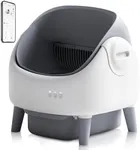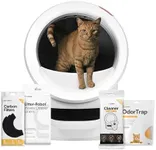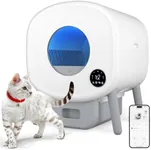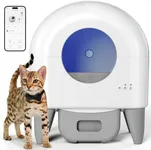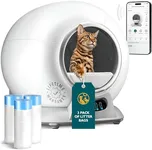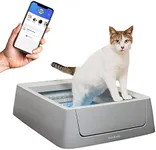Buying Guide for the Best Self Cleaning Cat Litter Boxes
Choosing the right self-cleaning cat litter box can make a significant difference in maintaining a clean and odor-free home while ensuring your cat's comfort. These devices automatically clean the litter, reducing the need for daily scooping and making pet care more convenient. To find the best fit for you and your feline friend, consider the following key specifications and how they align with your needs.Cleaning MechanismThe cleaning mechanism is how the litter box removes waste. This is important because it determines the efficiency and reliability of the self-cleaning process. There are various types, such as raking systems, rotating mechanisms, and conveyor belts. Raking systems use a rake to sift through the litter and remove waste, which is suitable for most cats. Rotating mechanisms rotate the litter to separate waste, which can be quieter and less intrusive. Conveyor belts continuously move the litter to remove waste, ideal for households with multiple cats. Choose a mechanism that matches your cat's habits and your preference for noise and maintenance.
Size and CapacitySize and capacity refer to the dimensions of the litter box and how much waste it can handle before needing to be emptied. This is crucial for ensuring your cat has enough space to use the box comfortably and for reducing the frequency of maintenance. Small litter boxes are suitable for single, smaller cats, while larger boxes are better for bigger cats or multi-cat households. Measure the space where you plan to place the litter box and consider your cat's size and number of cats to choose the right size and capacity.
Litter CompatibilityLitter compatibility indicates which types of litter can be used with the self-cleaning mechanism. This is important because not all litters work well with all systems. Some boxes require clumping litter, while others can handle crystal or silica gel litter. Clumping litter is widely available and effective at controlling odors, making it a popular choice. Crystal or silica gel litter absorbs moisture and controls odors well but can be more expensive. Choose a litter box that works with your preferred type of litter or be willing to switch to a compatible type.
Odor ControlOdor control refers to the litter box's ability to minimize unpleasant smells. This is important for maintaining a fresh-smelling home. Features like carbon filters, sealed waste compartments, and automatic waste removal can significantly reduce odors. If you are sensitive to smells or have a small living space, prioritize a litter box with strong odor control features. Consider how often you can empty the waste compartment and whether additional odor control products, like deodorizers, are needed.
Ease of CleaningEase of cleaning describes how simple it is to maintain and clean the litter box. This is important for ensuring the box remains hygienic and functional. Look for features like removable trays, washable components, and easy access to waste compartments. If you prefer minimal maintenance, choose a litter box with self-cleaning features that require less frequent manual cleaning. Consider your willingness to perform regular maintenance and how much time you can dedicate to cleaning the box.
Noise LevelNoise level refers to the amount of sound the litter box makes during the cleaning process. This is important for ensuring a peaceful environment for both you and your cat. Some self-cleaning mechanisms can be noisy, which might disturb sensitive cats or be disruptive in quiet homes. If your cat is easily startled or you prefer a quieter home, look for a litter box with a quieter cleaning mechanism. Consider the placement of the litter box and whether noise will be an issue in that location.
Power SourceThe power source indicates how the litter box is powered, which is important for ensuring it fits your home's setup. Some litter boxes plug into an electrical outlet, while others use batteries. Electric models are generally more powerful and reliable but require a nearby outlet. Battery-operated models offer more flexibility in placement but may need frequent battery changes. Choose a power source that matches your home's layout and your preference for convenience.
